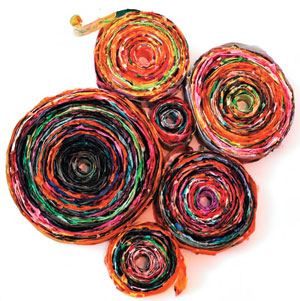Art with Impact
by Mindy Pantiel | photography by Greg Powers
In April 2013, Maya Freelon Asante ’05 stepped onto a balcony in the Bromo Seltzer Arts Tower in Baltimore and showered passersby with hundreds of pieces of brightly colored, water-stained tissue paper. The performance piece, titled Scattered to the Wind, was meant to highlight both the fragility and strength of art.
“The art I am creating now is about the beauty of the now, like a petal blooming.”
—MAYA FREELON ASANTE ’05
“The art I’m creating now is about the beauty of the now, like a petal blooming,” says the multi-media artist who was recently included in Huffington Post’s “Black Artists: 30 Contemporary Art Makers Under 40 You Should Know.” Poet Maya Angelou describes the artist’s work as “visualizing the truth about the vulnerability and power of the human being.”
“I come from a family of artists and have always been encouraged to follow my passion,” says Asante, who has exhibited at the Museum of the National Center of Afro-American Artists, Boston, other American venues, and internationally in Paris and Ghana. Acclaimed architect Philip Freelon is her father, and Grammy-nominated jazz artist Nnenna Freelon is her mother. Asante is collaborating on a theatrical production, The Clothesline Muse, with her mother and choreographer Kariamu Welsh, her mother-in-law.

Bloom Where You’re
Planted (17×13 in.),
composed of compressed
tissue paper, was completed in 2012.
It was in the basement of her grandmother, Queen Mother Frances J. Pierce, that Asante’s artistic passion crystallized one day in 2005 when she spied a stack of waterstained tissue paper. “Natural watermarks are my muse,” says Asante. “Signs that water was once there is something we humans relate to…from a dried creek bed, to a flood mark, to the ring around the tub.” Her late grandmother was crowned “Queen Mother” by the elders in Ghana and was an active and widely known member of St. Paul A.M.E. Church for more than 30 years. She held a master’s in education from Harvard University and taught elementary education as well as being an activist.
Asante turned that fascination into patchwork quilt-esque pieces such as a three-story sculpture at the U.S. Embassy in Madagascar (she also has permanent installations in embassies in Italy, Jamaica, and Swaziland) and in a work reminiscent of stained-glass titled Ubuntu—Take It to the Bridge for the Corcoran Gallery, Washington D.C.
Asante says the word ubuntu is a classical African concept that means “I am because we are.” “The paper itself is very fragile, but when you bring the smaller pieces together they get stronger and more resilient,” she says. “The world needs more peace and love so I try and create artwork that brings emotion and joy.”
 Her grandfather, acclaimed painter Allan Freelon, encouraged her to apply to Lafayette, where she happily felt as if she were in a fastpaced New York art school. She credits Curlee Raven Holton, David M. ’70 and Linda Roth Professor of Art and director of Lafayette’s Experimental Printmaking Institute, for creating that atmosphere. “I knew I had his support. He not only prepared me for graduate school, he drove and pushed me so I’d be prepared for the work world.” She has an MFA from School of the Museum of Fine Arts, Boston.
Her grandfather, acclaimed painter Allan Freelon, encouraged her to apply to Lafayette, where she happily felt as if she were in a fastpaced New York art school. She credits Curlee Raven Holton, David M. ’70 and Linda Roth Professor of Art and director of Lafayette’s Experimental Printmaking Institute, for creating that atmosphere. “I knew I had his support. He not only prepared me for graduate school, he drove and pushed me so I’d be prepared for the work world.” She has an MFA from School of the Museum of Fine Arts, Boston.
Other mentors are Lew Minter, retired director of the art department’s media lab, and Ed Kerns, Eugene H. Clapp II ’36 Professor of Art, who she says got her into the mindset of a working artist. “I’m a mixed-media artist so I took classes in everything from printmaking to working with clay,” she says.
As an undergrad, Asante received the Riley K. Temple ’71 Creative/Artistic Citizenship Award, was a Marquis Scholar, and studied at the American University in Paris. She is married to M.K. Asante ’04, author, filmmaker, hip-hop artist, professor, and recipient of the Langston Hughes Award, who recently published Buck: A Memoir. The couple splits their time, with their son Aion, 2, between their primary residence in Durham, N.C., and Baltimore.
All photographs are printed with permission of the artist.